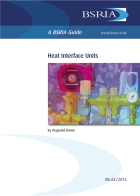Heat interface units

BSRIA’s guide to heat interface units (HIUs) focuses on the issues surrounding the application and installation of both direct and indirect HIUs for residential and small commercial applications in district or communal heat networks. It will assist specifiers, designers and installers to achieve a functional and efficient solution for space heating and hot water using heat interface units.
An HIU is an essential part of the efficient delivery of heating and hot water to consumers on district and communal heating schemes. The HIU provides safe connection of the consumers’ space-heating and hot-water systems, to the primary heat supply network together with the control function and metering.
The use of an HIU linked to a district or communal heat network in place of a boiler can have significant economic and environmental benefits depending on the source of heat and structure of the network. However, successful operation depends on appropriate system design and specification followed by competent installation and maintenance.
Catherine England, BSRIA marketing officer, said, ‘Over the past 20 years there has been increasing recognition that heat networks, enabled by the use of HIUs, particularly those associated with combined heat and power systems in urban areas, are a key element of a low carbon future.’








